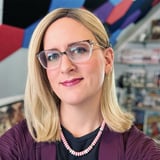Summary
Karen recounts how she helped grow GE Healthcare's design group from 28 to 60 people by acting as internal consultants across GE divisions during tough economic times. She partnered with design firms like Intersection to develop journey mapping tools and emphasized the involvement of business stakeholders alongside designers. On hiring the first diverse or non-traditional candidates, Karen stresses early alignment on criteria and seeking external community support to fairly evaluate and onboard these hires. Sam highlights the importance of using user research to pitch UX value in legacy-technical environments, leveraging real user frustrations captured in quotes and videos to create empathy and buy-in from skeptical stakeholders. Both underline the significance of focusing on measurable task success, error rates, confidence, and user delight when evaluating UX outcomes. They also share lessons from organizing “delight forums” aimed at building shared UX language inside organizations, noting their inspirational but limited practical impact. The conversation provides actionable strategies for scaling UX teams, engaging stakeholders, and making user-centered design tangible in complex, technical enterprises.
Key Insights
-
•
GE Healthcare's design group grew by acting as internal consultants to other GE divisions, funding growth through cross-unit projects.
-
•
Journey mapping was developed in partnership with an external firm, Intersection, to gain fresh perspectives on the user experience.
-
•
Involving business stakeholders alongside designers in journey mapping creates better alignment and broader buy-in.
-
•
Hiring non-traditional candidates requires early alignment on hiring criteria and leveraging external professional design communities.
-
•
Measuring UX success focuses on task completion rates, number of errors, user confidence, and subjective delight.
-
•
Physiological metrics for emotional responses in UX research have limited signal in everyday software usage due to noise.
-
•
“Delight forums” help build shared UX language but have limited impact without translating conversation into action.
-
•
Using authentic user stories and recorded frustrations can be more persuasive than abstract UX arguments when pitching to stakeholders.
-
•
Finding an internal ‘unindicted co-conspirator’ with a real problem helps UX designers demonstrate value practically.
-
•
Focus on where you’re welcomed in an organization to build momentum rather than forcing change where you face resistance.
Notable Quotes
"When I got there in very late ’07, there were about 28 people, now there’s about 60."
"We became entrepreneurs internally, doing work across other GE divisions to generate funding."
"Journey mapping was created with Intersection, founded by Chuck Pelley and Joan Greger, to help us look in the mirror."
"Align on what you’re looking for before the interview to evaluate non-traditional candidates fairly."
"We used standard metrics like task success, time to complete, number of errors, confidence, and delight."
"It’s hard to detect emotional responses physiologically in day-to-day software use because there’s too much noise."
"Delight forums helped us share stories and build a shared vernacular but didn’t lead to significant change by themselves."
"Instead of telling the story, bring in actual users to tell their frustration directly to your team and execs."
"Find an unindicted co-conspirator in your company with a problem you can help solve, and the rest will follow."
"Ignore the people who hate you, embrace those who love you, and focus on the fence sitters."
Or choose a question:
















More Videos

"Those roles enable others to do their best work and scale collaboration across teams."
Ned Dwyer Emily Stewart James WallisThe Intersection of Design and ResearchOps
September 24, 2024

"Government is seven plus years behind industry – not bleeding edge, more like the dull butter knife edge."
Michael LandEstablishing Design Operations in Government
February 18, 2021

"It took competitors over seven years to catch up to where Apple is with voice dictation and accessibility."
Sam ProulxTo Boldly Go: The New Frontiers of Accessibility
November 18, 2022

"We cleared three weeks of calendars to detach and look at the big picture — that was our UX reboot."
Vasileios XanthopoulosA Top-Down and Bottom-Up Approach to User-Centric Maturity at Scale
January 8, 2024

"A poor experience on a web visit isn’t out of sight, out of mind; it impacts their entire history with the brand."
Andrew Custage Michael MallettThe Digital Journey: Research on Consumer Frustration and Loyalty
March 29, 2023

"Don’t schedule your pilot during the holidays — our first pilot had one graduate because it went through December."
Marjorie Stainback Kelsey KingmanTransforming Strategic Research Capacity through Democratization
October 24, 2019

"Repair is any action that prevents negativity from spiraling out of control and helps bring people back to connection."
Alla WeinbergCross-Functional Relationship Design
December 6, 2022

"Sometimes the loudest voices dominate, but asynchronous collaboration helps give quieter voices a chance to speak."
Jerome “Axle” BrownHow to Use Self-Directed Learning to Ensure Your Research Insights are Heard and Acted Upon
March 11, 2021

"If you want to have tattoos, you can have tattoos and show them."
Jen Crim Jess Quittner Saritha Kattekola Alex Karr Gurbani PahwaCulture, DIBS & Recruiting
June 11, 2021















